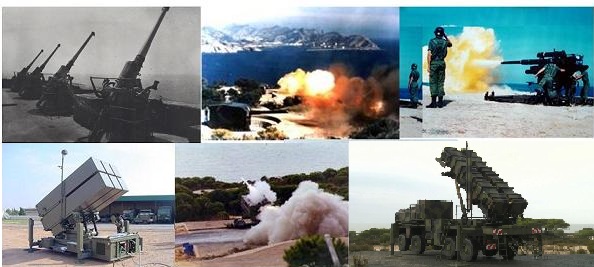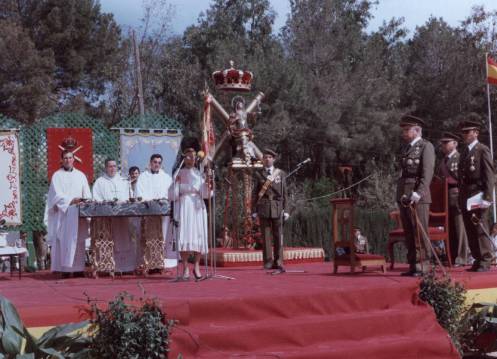MENÚ UNIDAD
ARMY UNITS
- Araba Álava |
- Albacete |
- Alicante |
- Almería |
- Asturias |
- Ávila |
- Badajoz |
- Barcelona |
- Burgos |
- Cáceres |
- Cádiz |
- Cantabria |
- Castellón |
- Ceuta |
- Ciudad Real |
- Córdoba |
- A Coruña |
- Cuenca |
- Girona |
- Granada |
- Guadalajara |
- Gipuzkoa |
- Huelva |
- Huesca |
- Islas Baleares |
- Jaén |
- León |
- Lleida |
- Lugo |
- Madrid |
- Málaga |
- Melilla |
- Murcia |
- Navarra |
- Ourense |
- Palencia |
- Las Palmas |
- Pontevedra |
- La Rioja |
- Salamanca |
- Segovia |
- Sevilla |
- Soria |
- Tarragona |
- Santa Cruz de Tenerife |
- Teruel |
- Toledo |
- Valencia |
- Valladolid |
- Bizkaia |
- Zamora |
- Zaragoza

Background
- pagination
-
Birth of the RAAA 73
The 73rd Anti-Aircraft Artillery Regiment (RAAA 73) was created by virtue of General Instruction (IG) 1/84 of the Chief of Staff of the Army (JEME), of January 9, as a unit of the General Reserve of the Army and on the basis of the 6th Mixed Artillery Regiment; thus, it became the depositary of the national ensign of the latter and heir of its history, which dates back to the 2nd Regiment of Foot Artillery created in 1802.In spite of its "anti-aircraft" denomination it was initially composed of the following battalions:o Coastal Artillery Battalion, that resulted from the merger of the two existing battalions (some of whose batteries had been disbanded);o 1st Anti-Aircraft Artillery Battalion, stationed in the neighborhood of Los Dolores (Cartagena);o 2nd Anti-Aircraft Artillery Battalion, following a change of the RAAA 72 Light Anti-Aircraft Artillery Battalion in Manises (Valencia), where it remained stationed.The Headquarters of the Regiment, the Head Office of the Coastal Artillery Battalion and the Services, Workshops and Ammunition Unit (USTyM) remained in the "Parque de Artillería" (Artillery Depot) barracks, their historical home base.On April 12, 1985 a new National Ensign was presented to the unit, in the form of a Standard, which replaced the one received from the 6th Mixed Artillery Regiment (RAMIX 6).On May 1, 1988, as set forth in the IG 4/88 of the JEME, the Regiment became part of the Anti-Aircraft Artillery Command created in Fuencarral (Madrid). -
Evolution of the RAAA 73
In 1993, under the provisions of the IG 01/93 of the JEME, the Coastal Artillery Battalion and the USTM were disbanded. The 2nd Anti-Aircraft Artillery Battalion was also split, being replaced by the 1st Light Anti-Aircraft Artillery Battalion that reported to the 75th Anti-Aircraft Artillery Regiment of Villanubla (Valladolid), which moved to Cartagena. In 1996 the unit vacated the emblematic "Parque de Artillería" to settle in the "Acuartelamiento Tentegorra" barracks, located in the outskirts of Cartagena. It comprised the following units and materiel:Headquarters1st Anti-Aircraft Artillery Battalion, equipped with the Skyguard 35/90-Aspide system2nd Anti-Aircraft Artillery Battalion, equipped with a Superfledermaus FCS and 40/70 cannonsIn 1993, the 2nd Battalion was equipped with a Mistral Missile Platoon in addition to its guns.In May 2002, the 2nd Centenary of the creation of the Artillery Regiment—to which the 73rdAnti-Aircraft Artillery Regiment is heir—was officially celebrated in Cartagena.Also in 2002, the organizational structure of the 2nd Battalion was modified after it was equipped with the NASAM System acquired by Spain; the systems that had been in use until then were decommissioned. The reception of the new materiel took place in May 2003.In June 2004, the NASAMS was declared operational and, in August 2006, the unit was sent to Sweden by sea, where it performed the first launch of AMRAAM missiles using the new system.In 2008, the unit was equipped with a Medium, Semi-Automatic, Anti-Aircraft Artillery Operations Center (known as COAAAS-M by its Spanish acronym), whose prototype had been tested years before by the Regiment; an essential element to exercise command and control in real time of all the associated anti-aircraft artillery weapon systems and their integration in the Air Defense System.In 2009, the Missile Maintenance and Storage Unit (UMAM) of the Regiment was designated as a High Specialization Body in charge of maintaining Aspide missiles—both those of the Army and the Air Force—and storing them and the NASAMS’ AMRAAMs. This Unit would report to the Maintenance and Supply Directorate (DIMA) – Army Logistics Support Command (MALE) on matters related to its functions.In 2016, the Organizational Adaptations of the Army led to disband the 81st Anti-Aircraft Artillery Regiment and change the denomination of the Battalion I/81 PATRIOT—headquartered in Marines (Valencia)—to Battalion III/73 PATRIOT. The latter was integratedin the Regiment and its headquarters remained at the General Almirante Barracks in Marines, Valencia.This battalion is equipped with the Patriot missile system, tactical anti-ballistic missile capability, cruise missiles, low Radar cross-section targets and state-of-the-art aircrafts.Before being integrated in this Regiment, it was the Generating Base-Unit of the Spanish Contingent deployed in the third rotation of the Support Operation to Turkey – "ACTIVE FENCE". Further operations were assumed by the RAAA 73.PARTICIPATION IN OPERATIONSUnits of the Regiment were designated to take part in anti-aircraft defense operations ofthe national territory on the following occasions:Hispanic-American Summit (Madrid, May 2002).European Union Summit (Seville, June 2002).Perejil Island conflict (Malaga, July 2002).Prestige Operation (Asturias and Galicia, January 2003)Marriage of HRH The Prince of Asturias (Madrid, May 2004)The NASAMS Battalion constituted the air defense unit of the seventh rotation of the NATO Rapid Response Force (NRF-7), being trained and activated during the second half of 2006 and remaining in a state of high-readiness, although its employment never became necessary.Operation R/A Base-Unit Generation OMLT 5/3-III (Afghanistan, 2011)Operation A/T Base-Unit Generation A/T IV, A/T V and A/T VI (Aldana, Turkey 2015/17)The Aspide Battalion constituted the Command and Control body of the NATO Very High Readiness Joint Task Force (VJTF) air defense unit (2015/16). -
Presentation of the Standard to the RAAA 73
April 12, 1985 will go down in the history of the 73rd Regiment of Anti-Aircraft Artillery, based in Cartagena, as one of the most endearing and emotional days for all of those who are part of it. Throughout its more than four centuries of history, rarely such a solemn act had been celebrated in the Los Dolores Barracks (Cartagena) where, presided over by His Excellency Captain General of the Levant Military Region, Mr. Manuel Vallespín González Valdés, the new National Standard—which replaced the National Flag of the former 6th Mixed Artillery Regiment—was delivered to the Regiment.




